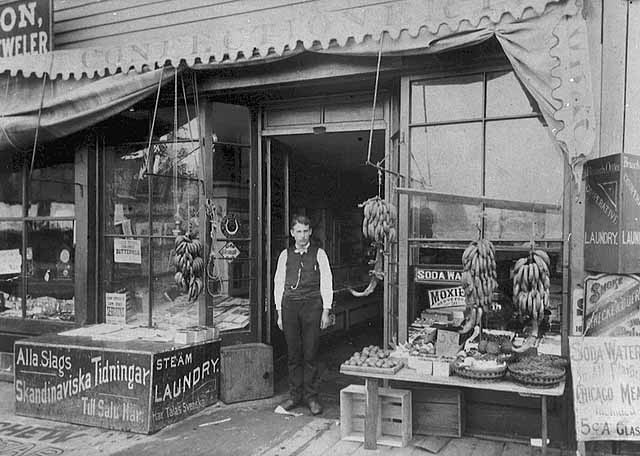When Cedar-Riverside was “Snusgatan”

Minneapolitans love to reminisce about the counterculture years of the West Bank/Cedar Riverside neighborhood. But for most of the neighborhood’s history, small immigrant businesses like the Otanga grocery store–which was destroyed in yesterday’s fire–have dominated the commercial landscape. Here we have a photo from the 1890s that shows Charles Samuelson standing in front of his store in Seven Corners. The sign at the front reads: “Har Talas Svenska” (Swedish spoken here) and “Alla Slags Skadinaviska Tidningar Till Salu Har” (All types of Scandinavian Newspapers for sale here). Samuelson was obviously catering to the residents of the immigrant-dominated neighborhood. In addition to newspapers, he stocked tobacco, candy, fruit and sodas in his store at the corner of Cedar and Washington Avenues.
“Snusgatan” or Cedar Riverside was the commercial center of the Scandinavian immigrant community at the turn of the twentieth century. New arrivals settled in boarding houses in the neighborhood, patronizing stores like Samuelson’s, where they were not expected to have a mastery of English. The neighborhood stood in close proximity to the city’s industrial zone, making it easy for new immigrants to walk to jobs in the mills. And after work, new arrivals could socialize in the neighborhood’s myriad dance halls, saloons, theaters and meeting halls. “Att ga pa Cedar” (to walk on Cedar) became shorthand for “to get drunk.” As immigrants started families and became more established, they tried to move out of the neighborhood. Scandinavians usually aspired to move into South Minneapolis, where they built large neighborhoods of working-class homes.
I’m guessing that both Charles Samuelson and the owners of the popular Otanga Grocery would have been equally perplexed by the media antics of the Electric Fetus music store, which staged a “naked sale” in 1972.
Photo is from the collections of the Minnesota Historical Society.